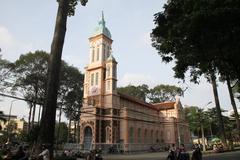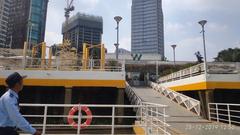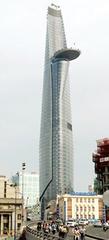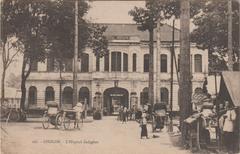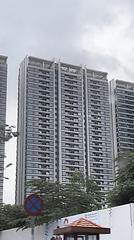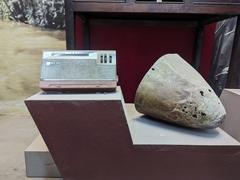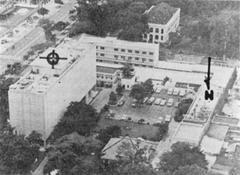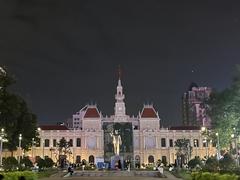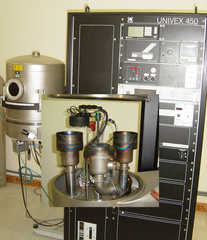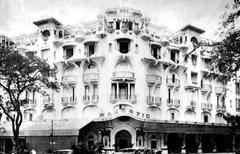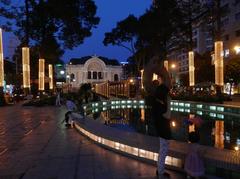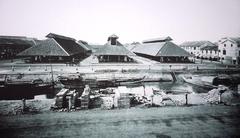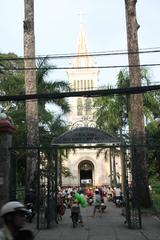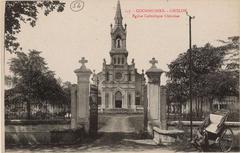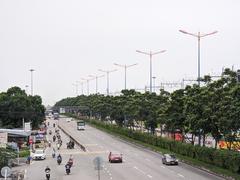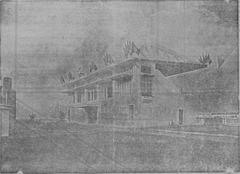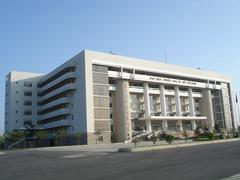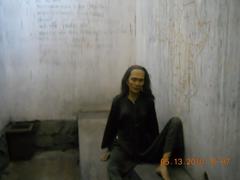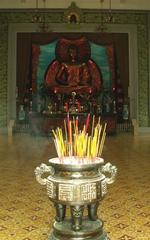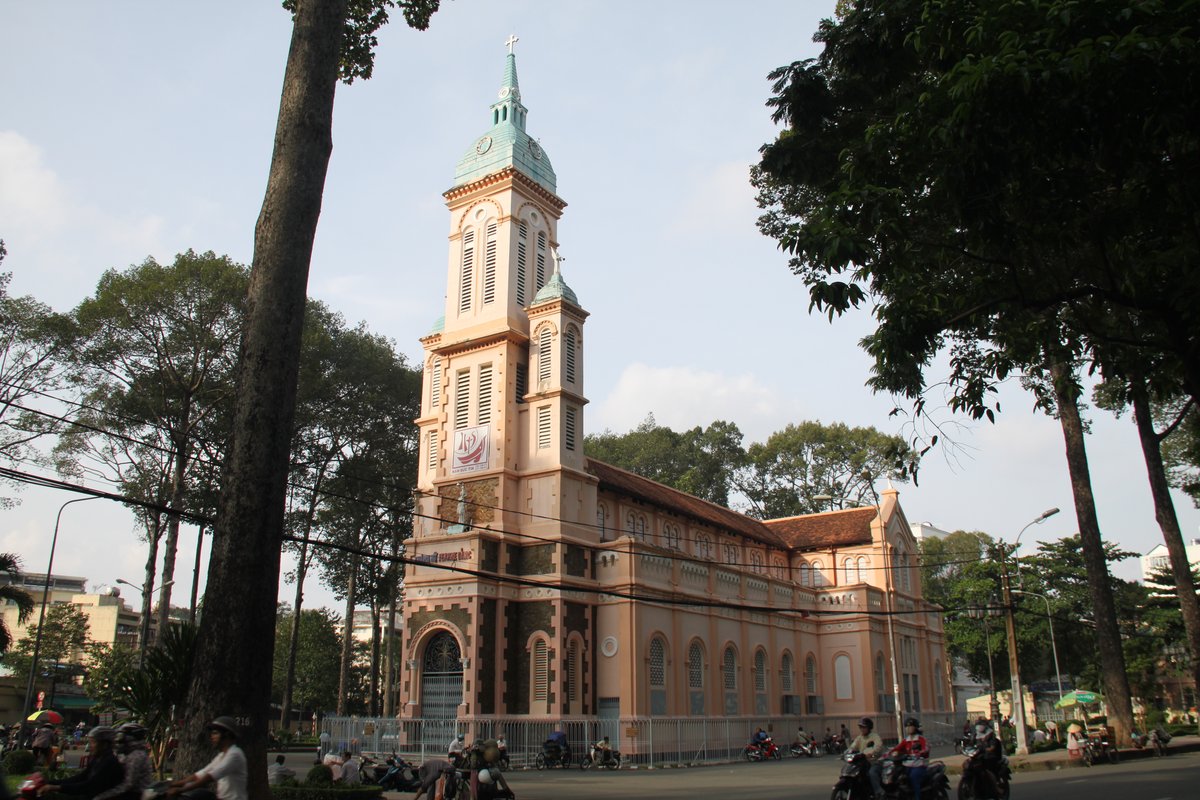
Jeanne D’Arc Church Visiting Hours, Tickets, and Historical Site Guide – Ho Chi Minh City
Date: 15/06/2025
Introduction
Located in the heart of Ho Chi Minh City’s District 5, Jeanne D’Arc Church (Nhà thờ Thánh Jeanne d’Arc) is a striking symbol of the city’s French colonial legacy, religious heritage, and multicultural vibrancy. Completed in the late 1920s and dedicated to Saint Joan of Arc—a figure representing courage, faith, and national identity—the church stands as both a spiritual sanctuary and a cultural crossroads. This guide provides a comprehensive overview of Jeanne D’Arc Church, covering its history, architecture, practical visitor information, and tips for making the most of your visit (dotchuoinon.com; Vietnam Online).
Historical Background
Colonial Origins and Community Roots
Jeanne D’Arc Church emerged during the expansion of Catholicism in southern Vietnam, a movement closely linked to French colonial administration in the early 20th century. The church was constructed between 1922 and 1928, coinciding with Joan of Arc’s canonization in 1920. Its establishment served not only the spiritual needs of the burgeoning Catholic community in Chợ Lớn (District 5’s Chinatown) but also reflected the colonial ambition to solidify French cultural presence in Indochina (adequatetravel.com).
The church’s location, at the historic Ngã Sáu (Six-Way Intersection), positioned it as a focal point for both religious activities and social gathering, especially among Chinese-Vietnamese (Hoa) Catholics. The original parish, founded in 1865, outgrew its first church, prompting construction of the larger Jeanne D’Arc Church on land previously used as a cemetery—a transformation symbolizing both renewal and continuity (giothanhle.net; vi.wikipedia.org).
Architectural and Artistic Highlights
Style and Structure
Jeanne D’Arc Church is renowned for its Neo-Gothic design, interpreted with local materials and adapted to Vietnam’s tropical climate. Key features include:
- Bell Tower: The central tower rises approximately 30 meters, making it a prominent landmark in District 5.
- Facade: Characterized by pointed arches, ribbed vaults, and pale yellow stucco contrasting with red-tiled roofs.
- Interior: The church follows a Latin cross floor plan, with a spacious nave illuminated by imported French stained glass windows that depict scenes from the life of Joan of Arc and traditional Christian motifs (Vietnam Tourism; Vietnamnet).
Artistic elements include statues of saints, fine woodwork on pews and the altar, and decorative stone and floral reliefs. The sanctuary features statues of the Virgin Mary, St. Joseph, and, uniquely, St. Jeanne d’Arc—represented in both her martyrdom and as a warrior-saint (giothanhle.net).
Cultural Adaptations
The church’s architecture marries European Gothic elements with adaptations for the local climate, such as high ceilings for ventilation, thick masonry for thermal insulation, and deep eaves to protect against sun and rain. Its grounds, shaded by mature trees, offer a tranquil environment for reflection and outdoor gatherings (Vietnam Heritage).
Spiritual and Community Role
Jeanne D’Arc Church has always been more than a place of worship. It is a community anchor for Catholics in District 5, hosting regular Masses, sacraments, charitable activities, and major celebrations such as the feast of St. Jeanne d’Arc on May 30. Its location at a literal crossroads and its history of serving both Vietnamese and Chinese Catholics underscore its inclusive spirit and multicultural legacy (tgpsaigon.net; vi.wikipedia.org).
Practical Visitor Information
Location
Address: 116A Hung Vuong Street, Ward 9, District 5, Ho Chi Minh City, Vietnam
(Try A Place)
How to Get There
- By Foot: From central landmarks such as Ben Thanh Market or Saigon Opera House, the church is within a 20–30 minute walk.
- By Bus: Bus No. 65 or 30 from Pham Ngu Lao backpacker area, alight at Hung Vuong and Tran Phu intersection (Evendo).
- By Taxi/Ride-Hailing: Widely available and convenient, especially in hot or rainy weather.
Visiting Hours and Entry
- Open Daily: 7:00 AM – 7:00 PM (some sources note dawn until dusk; best to visit during daylight hours)
- Admission: Free. No tickets required. Donations are welcome for maintenance.
Accessibility
- Wheelchair Access: Ramps at the main entrance and accessible restrooms.
- Family-Friendly: Spacious grounds suitable for groups and children.
Facilities and Etiquette
- Dress Code: Modest attire (shoulders and knees covered), hats removed inside.
- Photography: Allowed; avoid flash and be respectful during services.
- Restrooms: May not always be available onsite—plan accordingly.
- Shops/Cafés: Numerous options in the surrounding neighborhood.
What to See and Do
Must-See Features
- Bell Tower and Facade: A favorite for exterior photography.
- Stained Glass Windows: Best viewed in the morning or late afternoon light.
- Sanctuary Statues: Especially the unique depictions of St. Jeanne d’Arc.
- Courtyard: Shaded and peaceful, ideal for reflection.
Activities and Events
- Religious Services: Open to visitors; check schedules for Mass times (giothanhle.net).
- Feast Days: Major celebrations on May 30 (St. Jeanne d’Arc day) and other Catholic holidays.
- Community Gatherings: Cultural and charitable events reflecting the church’s outreach role.
Nearby Attractions
- Cholon Market and Chinatown: Rich in culture and history.
- Thien Hau Temple: A key Chinese-Vietnamese religious site.
- Notre-Dame Cathedral Basilica and Ben Thanh Market: Accessible by bus or taxi.
- Local Parks: Van Lang and Da Trach parks for relaxation (scootersaigontour.com).
Travel Tips
- Best Time to Visit: Early morning or late afternoon for cooler temperatures and softer light.
- Weather: Tropical, hot and humid year-round; rainy season is May–November—bring water and an umbrella (Wanderlog).
- Language: Vietnamese is primary, but some staff may speak basic English.
Frequently Asked Questions (FAQ)
Q: What are the opening hours of Jeanne D’Arc Church?
A: Daily from 7:00 AM to 7:00 PM (or dawn until dusk).
Q: Is there an entrance fee or are tickets required?
A: No, admission is free.
Q: Are guided tours available?
A: Occasionally, through local operators or by arrangement with the parish office.
Q: Is the church accessible for people with mobility issues?
A: Yes, ramps and accessible facilities are provided.
Q: What are nearby attractions?
A: Cholon Market, Thien Hau Temple, Notre-Dame Cathedral Basilica, Ben Thanh Market.
Preservation and Modern-Day Significance
Jeanne D’Arc Church has survived wars, regime changes, and urban modernization, remaining a resilient symbol of faith and cultural dialogue. Recent restoration projects have focused on maintaining its architectural integrity and adapting to the needs of a growing and diverse community (Vietnam Heritage).
Summary and Visitor Recommendations
Jeanne D’Arc Church is a vital part of Ho Chi Minh City’s religious and cultural landscape. Its blend of French colonial architecture, local adaptation, and dynamic community life make it a must-visit for travelers interested in history, spirituality, and urban culture. No tickets are needed, and visiting during off-peak hours ensures a peaceful experience. Remember to explore nearby attractions and engage with the welcoming local community for deeper insight (Evendo; giothanhle.net).
For further insights, immersive audio tours, and up-to-date visitor information, download the Audiala app and follow us on social media.
Sources and Further Reading
- dotchuoinon.com
- Vietnam Online
- Vietnam Tourism
- Vietnamnet
- giothanhle.net
- tgpsaigon.net
- Vietnam Heritage
- Evendo
- Try A Place
- adequatetravel.com
- vi.wikipedia.org
- scootersaigontour.com
- Wanderlog
